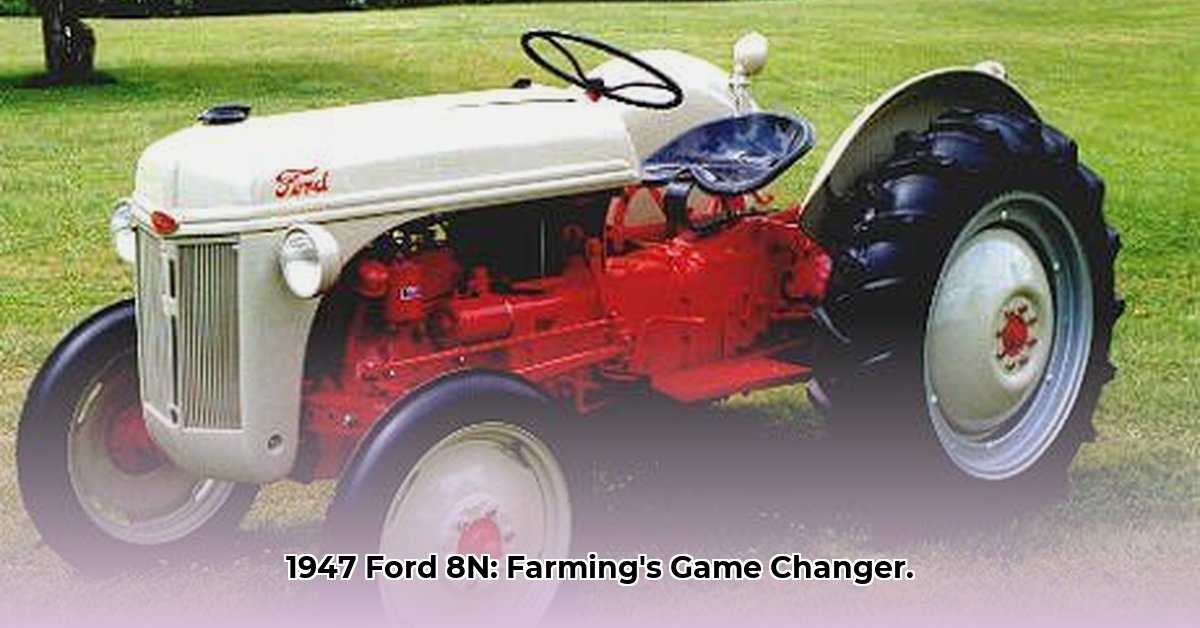
The 1947 Ford 8N tractor: a name perhaps unfamiliar to many, yet synonymous with a revolution in agriculture. This isn't merely a story about a machine; it's a narrative of post-World War II agricultural intensification, the unintended consequences of progress, and the ongoing quest for sustainable farming practices. We'll delve into its specifications, fuel efficiency (and how it stacks up against modern counterparts), and even practical maintenance tips. But more importantly, we'll explore the 8N's profound and lasting impact—how its success boosted food production while simultaneously presenting challenges to sustainable agriculture that we still grapple with today. For more on carburetor issues, see this helpful resource: 8N carburetor info.
A Workhorse's Story: Power, Limitations, and a Glimpse into the Past
The 8N, boasting a then-remarkable 20-horsepower engine (a significant leap from animal power), transformed farming. Imagine the difference: the unpredictable strength of a horse versus the reliable, controllable power of this small engine. Its three-point hitch system (a mechanism for attaching tools) – while simpler than modern versions – allowed for easy attachment of plows, harrows, and cultivators, increasing versatility. However, the 8N had limitations. Its rudimentary hydraulic system restricted the types of efficient implements it could handle, and many tasks still demanded considerable manual labor. Fuel efficiency also fell short of modern standards; each gallon of gasoline had a substantial environmental and economic impact. How did this impact the farmer's bottom line and the environment? This was a critical factor in its overall impact.
How the 8N Reshaped Farming Practices
The 8N's influence extended far beyond increased horsepower. It fundamentally reshaped farming practices. Larger fields could now be cultivated, leading to significantly higher yields. This spurred the rise of large-scale, monoculture farming (growing a single crop over vast areas). While increasing efficiency, this led to soil depletion and erosion – a constant cycle of intensive farming without adequate recovery time for the land. This is a clear illustration of the trade-off between increased productivity and long-term environmental concerns. Was the efficiency worth the environmental cost? The debate continues.
Sustainability: A Modern Perspective on a Vintage Machine
The 8N, reliant on gasoline, starkly contrasts with today's focus on sustainable agriculture. Its contribution to intensive farming practices, while incredibly productive at the time, also contributed significantly to the environmental issues we face now. Understanding its legacy is crucial; it highlights both the advancements and unintended consequences shaping modern farming. Studying its impact offers invaluable lessons as we strive towards more eco-friendly agricultural methods. What can we learn from the 8N as we seek to build a forward-thinking and sustainable farming sector?
Lessons Learned: Shaping the Future of Farming
The 8N's story serves as a powerful reminder that progress isn't always linear. Analyzing its past allows us to better navigate the future. This includes investing in research and development of more efficient, lower-emission tractors, exploring alternative fuels (such as biofuels), and transitioning from monoculture to more diverse farming practices that promote soil health and biodiversity, thus minimizing the need to rely solely on chemical fertilizers and pesticides. The potential of this research for a more sustainable agricultural system is immense.
The Enduring Legacy of a Simple Tractor
The Ford 8N is more than just a historical artifact; it's a compelling symbol. It signifies the start of mechanized farming, irrevocably altering our food production systems. Simultaneously, it reminds us that progress often brings unintended consequences. We've learned valuable lessons from its impact, constantly refining agricultural practices to ensure future generations benefit from both efficient production and a healthy planet. The 8N’s legacy stands as a testament to both remarkable progress and the crucial lessons we’ve learned.
Specifications Overview of the 1947 Ford 8N Tractor
| Feature | Specification | Notes |
|---|---|---|
| Engine | 20 horsepower, 4-cylinder | Considerably less powerful than modern tractors. |
| Transmission | 3-speed sliding gear | Simple, yet effective for its era. |
| Fuel Type | Gasoline | A significant contributor to its environmental impact. |
| Three-Point Hitch | Basic, early design | Innovative for its time, but limited the range of compatible tools. |
| Hydraulics | Limited hydraulics | Restricted the types and efficiency of tasks the tractor could perform. |
How Did the Ford 8N Tractor Impact Sustainable Farming Practices?
The 8N’s impact on sustainable farming practices is multifaceted. While increasing efficiency, it also inadvertently contributed to environmental challenges.
Accessibility and Efficiency: Before the 8N, farming was physically demanding and limited in scale. The 8N’s relatively low cost made mechanization more accessible and boosted productivity.
Design Innovations: The three-point hitch system increased versatility, optimizing the use of each tractor. This design element, still used today, demonstrates the 8N’s lasting impact.
Fuel Efficiency: The 8N's fuel consumption, while an improvement over animal power, was not particularly efficient by modern standards. This highlights the continuous need for improvement in farm machinery fuel efficiency.
The Funk Conversion Kit: This modification, designed to increase horsepower, actually increased fuel consumption, underlining the ongoing tension between output and environmental impact.
Community Building: The widespread use of the 8N fostered a sense of community among farmers, leading to invaluable knowledge-sharing and collaborative problem-solving. This unexpected benefit illustrates the indirect impact of technology on sustainable agriculture.
Key Takeaways:
- The 8N boosted agricultural efficiency, allowing farmers to cultivate more land with less manual labor.
- Increased accessibility to mechanization improved yields and food security.
- The three-point hitch system substantially enhanced versatility.
- Although fuel efficiency was limited, productivity gains partially offset higher fuel consumption.
- The 8N fostered a supportive community, resulting in valuable knowledge sharing.
- Modifications like the Funk conversion kit highlighted the constant need to balance productivity with environmental concerns.